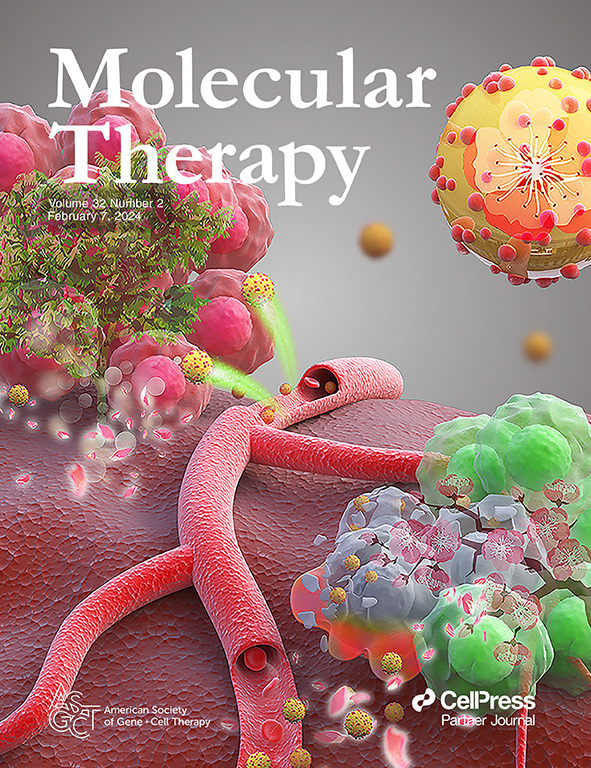基于aav基因治疗弗里德赖希共济失调眼部表型的研究进展。
IF 12
1区 医学
Q1 BIOTECHNOLOGY & APPLIED MICROBIOLOGY
引用次数: 0
摘要
弗里德赖希共济失调症(FA)是一种主要的遗传性共济失调症,由fraataxin (FXN)常染色体隐性突变引起。GAA三联体重复扩增导致FXN表达水平降低,铁异常流入线粒体和神经系统损伤。患者通常在第二个十年前出现肌肉功能丧失、语言障碍和心肌病。在后期阶段,通常表现为视力丧失。研究人员正在开发针对心脏和中枢神经系统表现的基因疗法,但它们的给药途径并不能导致视网膜的有效转导。本研究的目的是开发一种更直接的方法来治疗FA的眼部表型,包括视网膜神经节细胞(RGCs)的丧失、视网膜神经纤维层(RNFL)的变薄、视神经萎缩和视野的丧失。我们建立了两种新的条件敲除(KO)模型,mRx-Fxn KO和Pou4f2-Fxn KO小鼠,其中Fxn分别在所有视网膜细胞或RGCs中被切除,并表明Fxn缺乏导致两种模型的视网膜营养不良。通过玻璃体内注射携带FXN的新型基于aav2的衣壳补充基因,在两种模型中部分保留了视网膜结构和/或功能,建立了这种治疗策略的概念证明。本文章由计算机程序翻译,如有差异,请以英文原文为准。
Development of an AAV-Based Gene Therapy for the Ocular Phenotype of Friedreich's Ataxia.
Friedreich's Ataxia (FA) is a leading form of hereditary ataxia caused by autosomal recessive mutations in frataxin (FXN). GAA triplet repeat expansions lead to lower levels of FXN expression, abnormal influx of iron into mitochondria and damage to the nervous system. Patients typically present before the second decade with loss of muscular function, speech impediments, and cardiomyopathy. At later stages, vision loss typically manifests. Work is underway to develop gene therapies that address the cardiac and CNS manifestations, but their routes of administration do not lead to efficient transduction of the retina. The purpose of this study was to develop a more direct approach for treating the ocular phenotype of FA which includes loss of retinal ganglion cells (RGCs), thinning of the retinal nerve fiber layer (RNFL), optic nerve atrophy, and loss of visual field. We generated two novel conditional knock-out (KO) models, mRx-Fxn KO and Pou4f2-Fxn KO mice, wherein Fxn is ablated in all retinal cells or RGCs, respectively and showed that FXN deficiency led to retinal dystrophy in both models. Gene supplementation via intravitreal injection of a novel AAV2-based capsid carrying FXN partially preserved retinal structure and/or function in both models, establishing proof-of-concept for this therapeutic strategy.
求助全文
通过发布文献求助,成功后即可免费获取论文全文。
去求助
来源期刊

Molecular Therapy
医学-生物工程与应用微生物
CiteScore
19.20
自引率
3.20%
发文量
357
审稿时长
3 months
期刊介绍:
Molecular Therapy is the leading journal for research in gene transfer, vector development, stem cell manipulation, and therapeutic interventions. It covers a broad spectrum of topics including genetic and acquired disease correction, vaccine development, pre-clinical validation, safety/efficacy studies, and clinical trials. With a focus on advancing genetics, medicine, and biotechnology, Molecular Therapy publishes peer-reviewed research, reviews, and commentaries to showcase the latest advancements in the field. With an impressive impact factor of 12.4 in 2022, it continues to attract top-tier contributions.
 求助内容:
求助内容: 应助结果提醒方式:
应助结果提醒方式:


